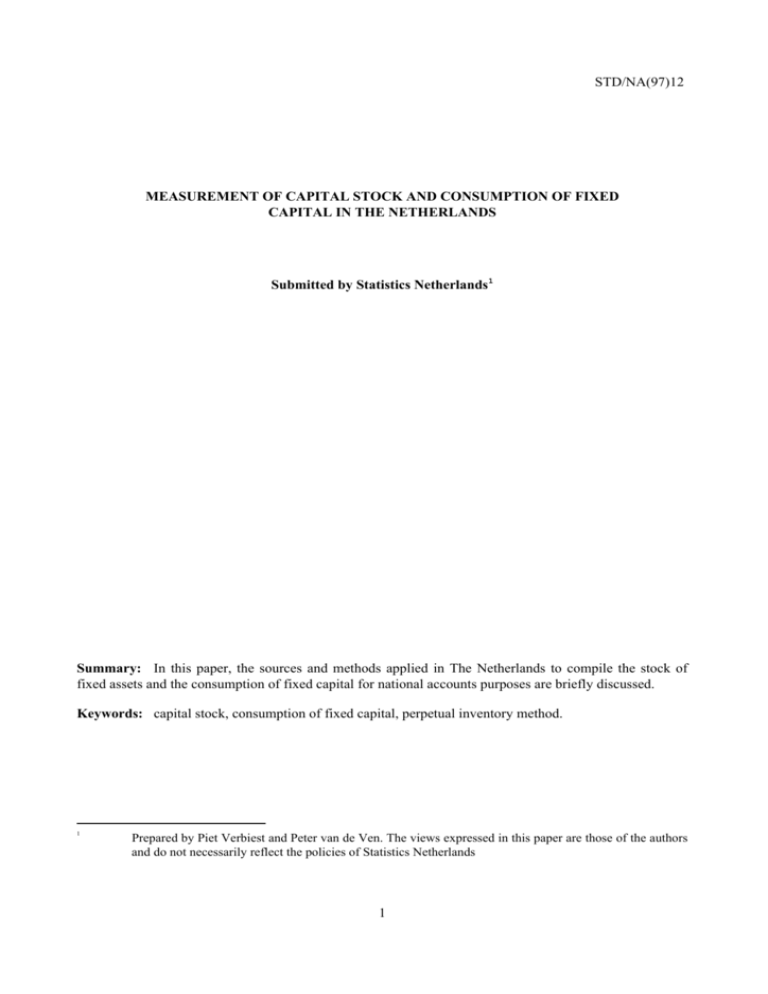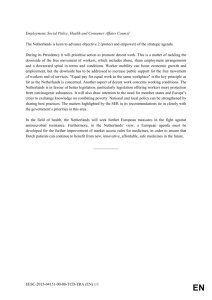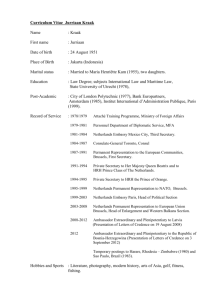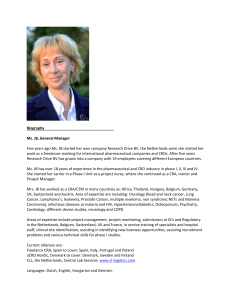STD/NA(97)12 1 MEASUREMENT OF CAPITAL STOCK AND
advertisement

STD/NA(97)12 MEASUREMENT OF CAPITAL STOCK AND CONSUMPTION OF FIXED CAPITAL IN THE NETHERLANDS Submitted by Statistics Netherlands1 Summary: In this paper, the sources and methods applied in The Netherlands to compile the stock of fixed assets and the consumption of fixed capital for national accounts purposes are briefly discussed. Keywords: capital stock, consumption of fixed capital, perpetual inventory method. 1 Prepared by Piet Verbiest and Peter van de Ven. The views expressed in this paper are those of the authors and do not necessarily reflect the policies of Statistics Netherlands 1 STD/NA(97)12 Introduction In The Netherlands, the “perpetual inventory method” (PIM) is applied for the calculation of the stock of fixed assets and the consumption of fixed capital. Using information on gross fixed capital formation (I) in subsequent years and the expected service life of the assets (d), the gross stock of fixed assets is calculated as follows: d −1 (1) SFCt ,t = ∑ I t −i * Pt −i ,t i =0 of which: SFCt,t = stock of fixed assets (gross) in year t in prices of year t Pt-i,t = price index of year t with base year t-i Subsequently, assuming a straight-line depreciation of the fixed assets and an even distribution of the acquisitions of fixed assets over a year, consumption of fixed capital (CFC) is compiled as follows: (2) CFCt ,t = 1 / d * ( SFCt ,t + SFCt −1,t ) / 2 For the calculation of capital stock and consumption according to PIM, several assumptions need to be made, and certain data requirements need to be met. In the following, both the assumptions and the data used in The Netherlands will be discussed. Subsequently, attention will be paid to the assets which are (not) taken into account, the survival function, the depreciation pattern, the determination of the average expected service life, and the data available on fixed capital formation. The paper concludes with some recommendations for further research. Fixed assets taken into account The present Dutch national accounts are in line with the European System of Integrated Economic Accounts (ESA) 1979. As such, consumption of fixed capital is calculated “for all reproducible fixed capital goods, with the exception of capital goods for collective use with an indeterminate life time (roads, bridges, etc.)” (ESA 1979, paragraph 403). Also livestock is excluded from the calculation of capital consumption. Furthermore, most intangible assets like software and artistic originals, and durable goods acquired by general government for military purposes are not taken into account; most of these goods and services are not treated as fixed capital formation in ESA 1979. At present, the following eight types of fixed assets are distinguished when compiling estimates of capital stock and consumption: − dwellings; − non-residential buildings; − other civil construction and works; − aeroplanes; − ships; 2 STD/NA(97)12 − trains; − other transport equipment; − machinery and other equipment. Survival function An important issue, especially in relation to the calculation of the capital stock, is the survival function applied. It may be expected that the retirement of a certain vintage of capital goods will not take place at once. A spread around the average expected service life is normal. On the one hand, some capital goods will be retired prematurely because of obsolescence or accidental damage; on the other, some capital goods may have a service life longer than average because of careful use. By specifying a survival function, this spread can be taken into account. Introducing a specific survival function, however, complicates calculations considerably. The literature on survival functions is extensive. Maddison (1992) and Eurostat (1991) give an overview of the patterns used in a number of countries. From this overview it can be derived that most countries - including The Netherlands - do not take into account this spread: a vintage of capital goods is retired at once when the average expected service life is reached. Exceptions are e.g. Germany (gammafunction), the United Kingdom (symmetrical spread of 20% around the average expected service life) and the USA (bell-shaped spread of 55% around the average expected service life). In his study, Maddison (1992) however concludes that: “Judging by the evidence available for countries where alternative assumptions have been tested (i.e. France, Germany, UK and USA), estimates of the level and growth of capital stock are not very sensitive to plausible variations in the retirement patterns, so I use the simplest (rectangular) assumption”. Eurostat (1991) “will use for its own calculations the log-normal function, and recommend to the Member States to do the same”. As stated, the rectangular retirement is applied in The Netherlands. Only exceptional cases, like the closure of the coal-mines in the seventies, are taken into account. In addition, the capital stock is corrected for the disposal of ships and aeroplanes (to the rest of the world), and leased cars (to consumers). Depreciation pattern Another important issue in relation to the calculation of the capital stock and consumption by means of PIM is the depreciation pattern applied. From a theoretical point of view, several patterns can be distinguished depending on the rate at which the efficiency of a given asset, or the rate at which the inputs into production obtained from the use of a given asset, varies over time. SNA 1993, paragraph 6.190 mentions three possible profiles: Constant efficiency until the asset disintegrates; for example, an electric light bulb; A linear decline in efficiency; the service life ends when efficiency declines to zero; A constant geometric, or exponential, decline in efficiency. It can easily be demonstrated that combining profiles (a) and (b) is capable of generating a constant rate of capital consumption over the life of the asset, i.e. that it can lead to constant or “straightline depreciation” (SNA 1993, paragraph 6.193). Ward (1976) states that “for most assets, especially those 3 STD/NA(97)12 with long lives and those like buildings where the services they provide do not materially change over time, the conventional straight-line estimate of annual factor services used up seems appropriate. For some machinery and equipment this particular method may be inappropriate because many types of equipment are comparatively more productive when still new. In such cases, a reducing balance, or double declining method, which attaches a greater value to the capital services provided in earlier years, may be more appropriate”. For reasons of simplicity, the straight-line depreciation method is applied for all assets in The Netherlands. Determination of average expected service life The role of the average expected service life in the calculation of capital stock and consumption is twofold. On the one hand, the service life is (one of) the most important determinants in the method of calculation. On the other hand, it determines the necessary length of the time series of data on fixed capital formation. Information on the expected service life of an asset can be derived from three possible sources: depreciation allowances for income tax purposes, business accounting practices, and direct observation of the interval between the date of installation and the date of final retirement. Each of the methods has its advantages and its drawbacks; see also Ward (1976). In the absence of information from direct observation, most countries use fiscal data to approximate the service life. In The Netherlands, however, the “Statistiek Kapitaalgoederenvoorraad” (Statistics on Capital Stock) and the “Desinvesteringsenquête” (Questionnaire on Disinvestments) provide directly observed data on service lives of different types of assets for a number of industries. These data are used in the calculation of capital stock and consumption. Whenever information is absent, data for comparable industries and/or types of assets are used; in addition, some expert guesses are made. Table 1 gives an overview of the average expected service life per type of asset. Table 1. Average expected service life by type of asset Type of asset Dwellings Service life in years 100 Non-residential buildings 20-55 Other civil construction and works 30-50 Aeroplanes 15 Ships 22 Trains 28 Other transport equipment 12-25 Machinery and other equipment 10-21 4 STD/NA(97)12 In general, the average expected service life of non-residential buildings is approximately 55 years; the service life of buildings in agriculture, however, is set equal to 20 years because of their rather specific use (cowsheds and pigsties). The service life of other civil construction and works normally equals 35 years; exceptions are public transport (50 years) and communication (30 years). For other transport equipment, the service life is usually set equal to 12 years, with one or two exceptions upwards. Finally, the picture for machinery is rather diverse, not surprisingly because of the heterogeneity of this category; for most industries, an average expected service life of 18-19 years is applied. In The Netherlands, the average expected service life is assumed to be constant over time. This assumption is questionable. For example, an unexpected price increase of labour input relative to capital input may result in an accelerated retirement of the less efficient old vintages, and vice versa. Furthermore, there is evidence to support the assumption of a structurally decreasing service life of some assets. A report about German practice states: “As far as motor vehicles are concerned, the available material shows that the lifetime in 1970 was essentially shorter than in 1955. The results of the 1969 enquiry conducted by the Ifo-institute of Economic Research in Munich, among close to 3,000 manufacturing enterprises, also confirm the time trend towards a shorter lifetime” (Lützel, 1977). From Eurostat (1991), it can be derived that Germany indeed assumes a structural decline of the average service life, of 0.5% per year. Besides Germany, in the European Union only the UK assumes a varying service life. Time-series of data on fixed capital formation Table 1 shows that time series of gross fixed capital formation of considerable length are needed for the calculation of capital stock and consumption, especially for dwellings, and to a lesser extent nonresidential buildings and other civil construction and works. In The Netherlands, the latest revision of national accounts data has taken place for the reference year 1987; consistent time series of capital formation according to the sources and methods of this revision are available from 1948 onwards. It should be noted, however, that up to now the data for the period 1948-1968 could only be estimated by a rough extrapolation of volume and price changes. In addition to these time series, estimates of the capital stock for enter-prises (including owner-occupied dwellings) and government are available for 1948 and 1952, respectively (Korn and Van der Weide, 1960). In estimating capital stock and consumption, a distinction could be made into 25 industries and 8 types of assets (see table 1). The allocation of capital formation to industries is based on the principle of economic ownership, i.e. capital formation is allocated to the industry that ultimately bears the economic risk of investing. As such, capital formation is allocated to the lessee in case of financial leasing, and to the lessor in case of operating leasing. Especially in the case of buildings, the average expected service life exceeds the length of the time series of gross fixed capital formation. As a consequence, additional assumptions had to be made in relation to the vintage-structure of the capital stock in 1948 and 1952, respectively. It has been assumed that the stock is equally spread over the relevant years, and that the annual investments for the industries and types of assets distinguished equal 1 / d * SFC1948 (resp. SFC1952 ) . Concluding remarks At the moment, the Dutch national accounts are being revised to align them with SNA 1993 and ESA 1995. In addition, new sources of information will be introduced. The first results of this revision will become available in 1999 for the reference-years 1995 up to and including 1998. A major project of the 5 STD/NA(97)12 1995 revision is the improvement of the estimates for capital stock and consumption. Especially, attention will be paid to: − inclusion of intangible fixed assets, and fixed capital formation for military purposes in accordance with SNA 1993; − further research into the estimates of average expected service life. In this research, use will be made of the results from the “Desinvesteringsenquête” (Questionnaire on Disinvestments). Also the possibility and desirability to introduce survival functions and variable average service lives will be taken into account here; − whenever feasible: updating capital stock estimates calculated according to PIM by integrating them with more recent information on capital stock directly observed. Dwellings, non-residential buildings, and equipment for some industries (especially industrial activities) may be feasible. However, differences in definition and starting point between PIM-estimates of capital stock on the one hand and capital stock directly observed on the other may be important. Further research is needed into the possibility to quantify these differences; and − for recent years (from 1986 onwards), more detailed information is available for gross fixed capital formation. This concerns the subdivision into industries as well as types of assets. As a consequence, more accurate calculations of capital stock and consumption can be compiled by introducing more specific information on average expected life service. Literature Eurostat, 1991, Eurostats Work on Capital Stock (Item 8 on the Agenda of the meeting of the Working Party on National Accounts, Luxembourg 10-12 December 1991), Eurostat, Luxembourg. Eurostat, 1995, European System of Accounts (ESA 1995), Eurostat, Luxembourg. Korn, B. and Van de Weide, Th.D., 1960, Het nationale vermogen van Nederland 1948-1958 (National Wealth of The Netherlands 1948-1958), Statistische en Econometrische Onderzoekingen, CBS (Statistics Netherlands), Voorburg (only available in Dutch). Lützel, H., 1977, Estimates of Capital Stock by Industries in the Federal Republic of Germany, Review of Income and Wealth (March 1977). Maddison, A.M., 1992, Standardised Estimates of Fixed Investment and Capital Stock at Constant Prices: a Long Run Survey for 6 Countries, Paper for the 22nd General Conference of the International Association for Research in Income and Wealth (IARIW), Flims, Switzerland. United Nations, Commission of the European Communities, International Monetary Fund, Organisation for Economic Co-operation and Development, World Bank, 1993, System of National Accounts 1993 (SNA 1993), Series F, No. 2, Rev. 4, United Nations, New York. Verbiest, P., 1996, De kapitaalgoederenvoorraad in Nederland (Fixed Capital Stock in The Netherlands), Internal Paper 4842-96-DFB.PNR, CBS (Statistics Netherlands), Voorburg (only available in Dutch). Ward, M., 1976, The Measurement of Capital, Organisation for Economic Co-operation and Development, Paris. 6







